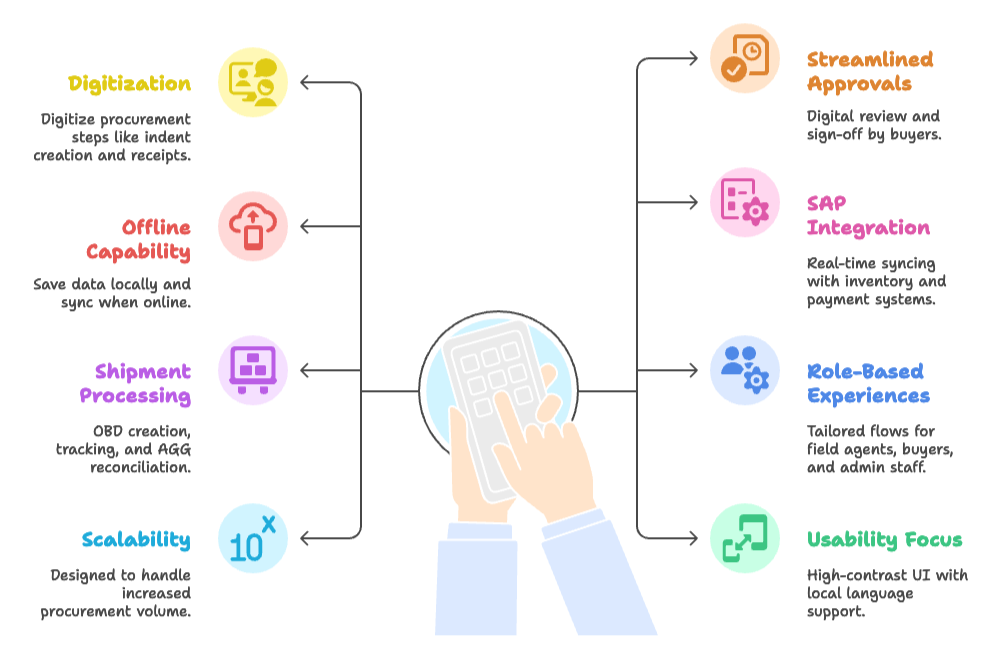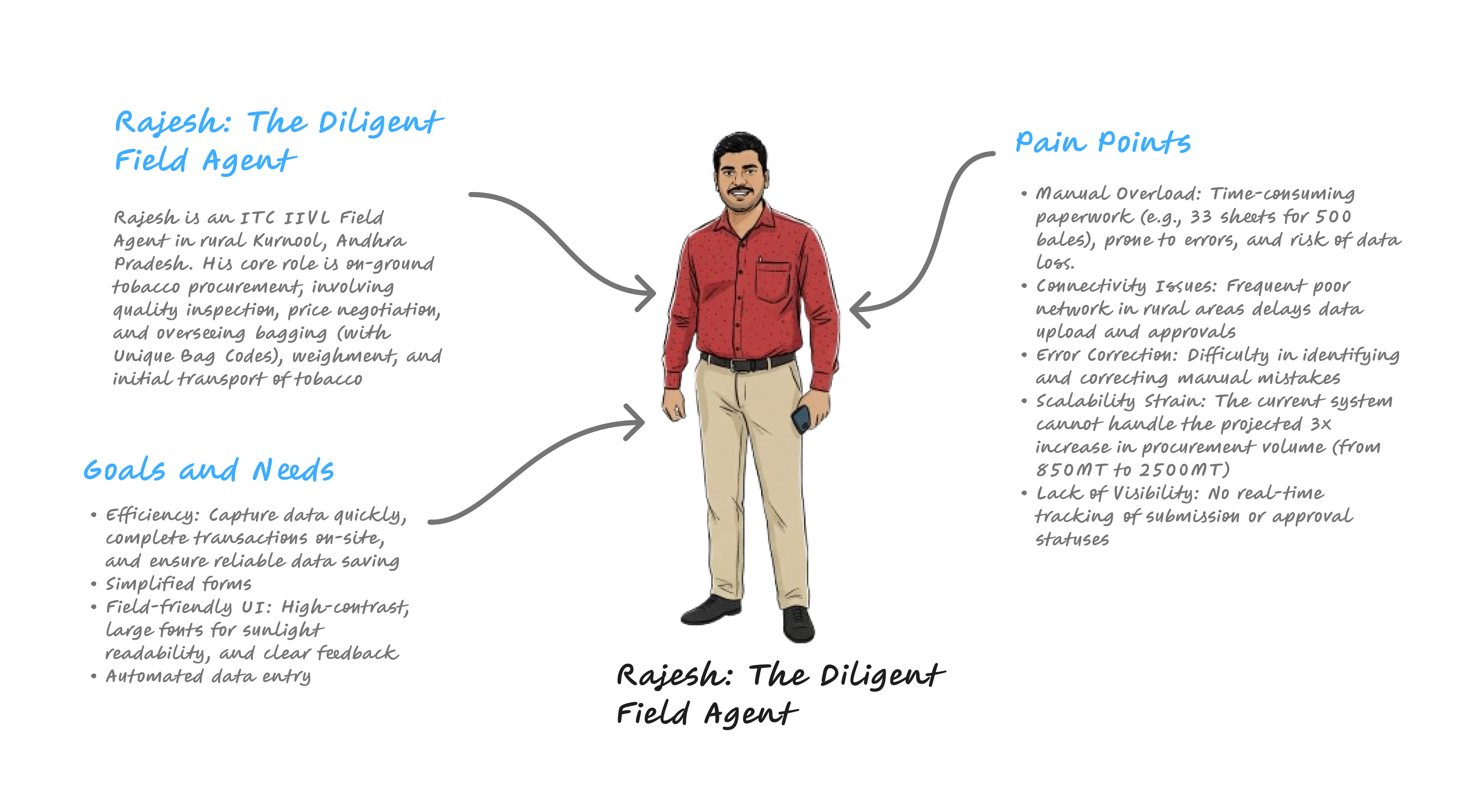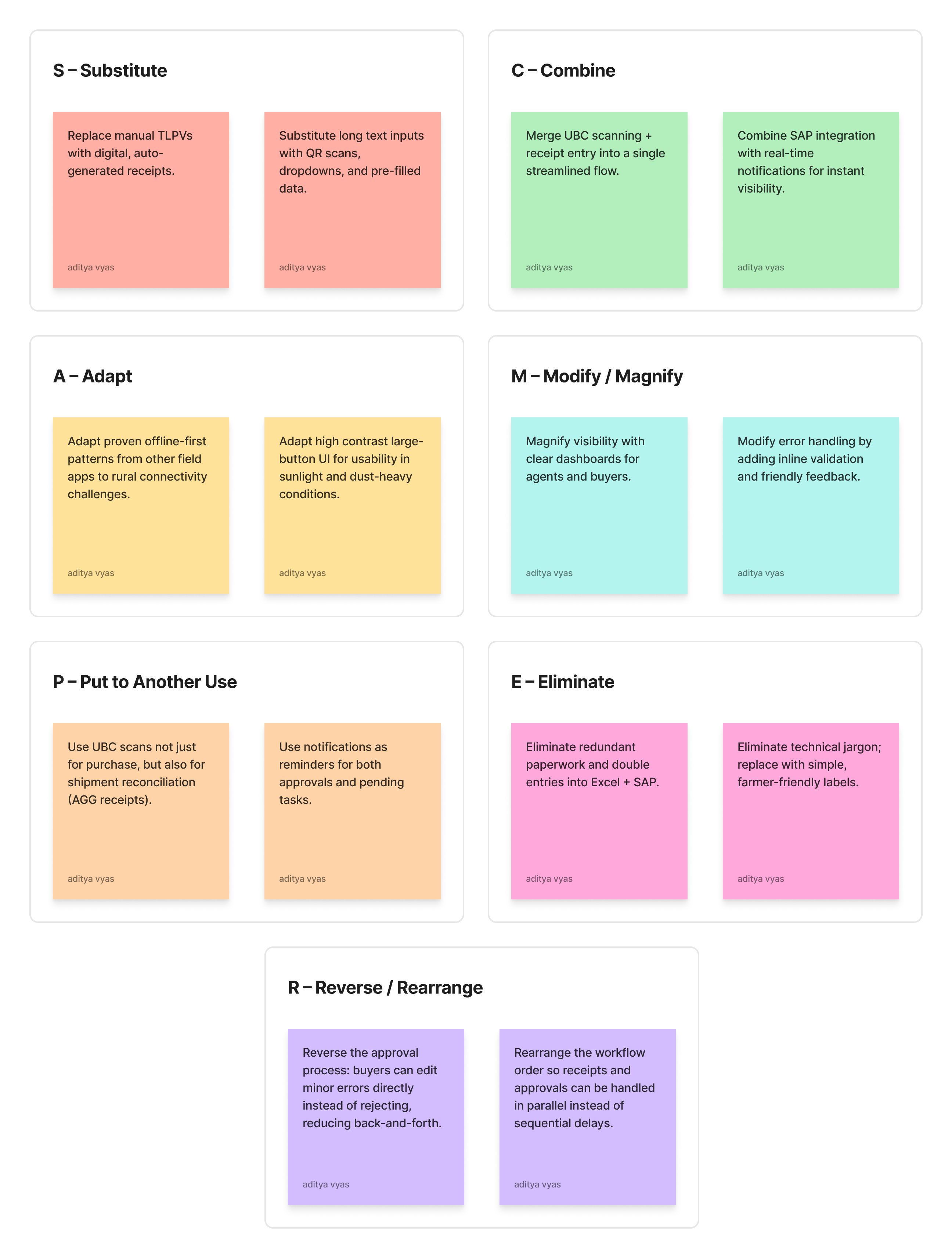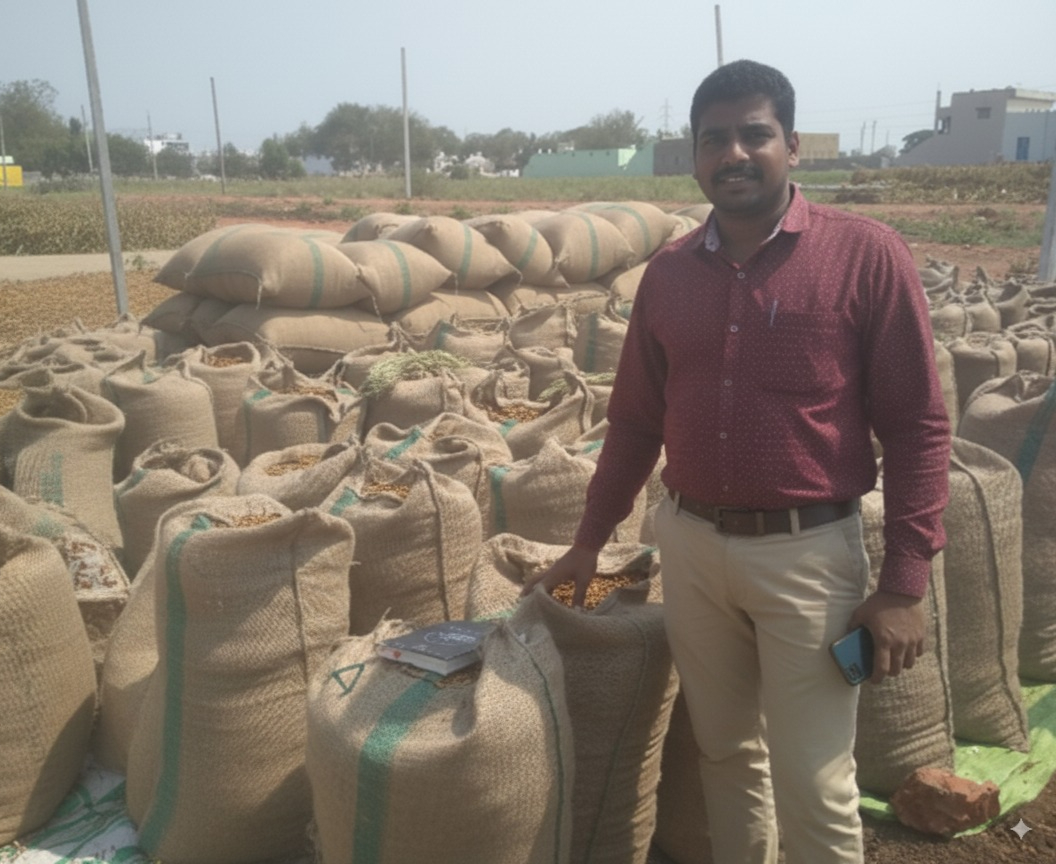
Reading time : 20 mins
Deep Dive -The Tobacco Turnaround
From slow approvals and paperwork overload to a scalable, field-ready app—this project captures the transformation of an entire procurement cycle.
Client : ITC IIVL
My Role : Product Designer
Domain : ERP, Supply chain Digitization, Field Operations Automation,
The Business aimed to
digitize procurement and eliminate inefficiencies by creating a mobile-first, field-ready solution that was faster, scalable, and field-ready, capable of reducing errors, accelerating approvals, and creating transparency across the procurement cycle.
At its core, this wasn’t just about building an app. It was about helping field agents like Rajesh work faster, giving buyers like Kartik clarity and control, and enabling ITC to scale procurement from 850MT to 2500MT—without chaos.
Challenges
-
Manual data entry and paperwork led to frequent errors.
-
Approvals were slow and created bottlenecks.
-
Field operations and SAP worked in silos, with delayed syncing.
-
Connectivity gaps in rural areas prevented real-time updates.
-
The existing setup couldn’t scale to handle 3X procurement growth.

%201.png)


Empathise & Research
Understanding the Client Input
Research Starts with Listening
The project began with a detailed deck from ITC IIVL management that outlined their vision, strategy, and the foundation for digitization.
The deck included:
-
The business challenges.
-
Process documentation and rough user flows.
-
Digitization Requirements.
-
Key Actors.
Armed with this clarity, I began my research by thoroughly analyzing process flows, business requirement docs, and workshop presentations. This helped uncover the operational constraints, user pain points, and scale of transformation required—laying a strong foundation for user-centered design.




Context Mapping
Before shaping the solution, I needed to see the ground reality beyond ITC IIVL’s improvement list. Being based in Hyderabad, I visited the Kurnool farms, met field agents, and shadowed their daily procurement work—uncovering pain points that documents alone couldn’t reveal.
Key Realities & Challenges:
-
Remote rural procurement with poor or no connectivity.
-
Manual paperwork and Excel sheets caused frequent delays and errors.
-
SAP handled inventory/payments but was disconnected from field operations.
-
Multi-step processes (indent creation, UBC scanning, approvals, shipments) were fully manual.
-
Approval cycles were slow due to paperwork and repeated corrections.
-
Scaling from 850MT to 2500MT was impossible with the existing system.


%201.png)

Requirement Gathering
Based on these challenges and stakeholder inputs, the system requirements were defined to address both business and user needs.

User persona


Brainstorm &
UX Workshop
Brainstorming with SCAMPER
The SCAMPER method helped me stretch the ideas by questioning and reimagining the current process at every step.


"Recognition Rather than Recall"
Worst Possible Idea!
To spark creativity and uncover hidden assumptions, we used the "Worst Possible Idea" technique—intentionally proposing bad solutions to provoke fresh thinking.
Worst Idea #0 : Let’s give agents the cheapest, worst camera devices so scans fail most of the time.
What it inspired : Optimized QR scanning with fallback manual entry.
Worst Idea #1 : Let’s make the app difficult to use outside in fields.
What it inspired : Implementation of a high-contrast, WCAG compliant visual design, ensuring optimal readability in outdoor conditions.
Worst Idea #2 : Let's make users type everything manually, including 15-digit UBC codes, locations and names.
What it inspired : QR code scanning for Universal Bag Codes (UBCs), complemented by dropdowns and pre-filled fields to drastically minimise manual input and reduce errors
Worst Idea #3 : Let’s make the app ultra-modern/Trendy with glass effects, neumorphism, color overload, detailed illustrations, and animated icons everywhere!
What it inspired : A clean, minimal, clutter-free UI with large buttons, simple layouts, and clear focus on functionality—built for speed, usability, and visibility in tough field conditions.
User Stories@
Simple, functional, and role-based experiences tailored for every actor.

User Flows
Translating user stories into structured, actionable workflows for every persona.
These flows cover all key interactions, accounting for offline/online status, data entry, review, approval, and error handling.
Flow 1-Field Agent (Rajesh) : Purchase & TLPV Generation
🎯 Goal: Capture procurement data on-site and submit it for buyer approval

Flow 2-Buyer (Kartik) : TLPV Review & Approval
Goal: Review and take action on submitted TLPVs.
.png)
Flow 3-Field Agent (Rajesh) : Outward Bound Delivery Processing
Goal: Record and upload dispatch details for all UBCs to SAP.
.png)
Flow 4-Warehouse/Receiving Point : AGG Receipt & Reconciliation
Goal: Verify received bags against dispatch and record AGG receipt.


"If I had asked people what they wanted, they would have said faster horses"
Wireframes

Low-Fi Screens
Designs
After multiple rounds of iteration and feedback, the wireframes evolved into the final designs—screens that were simple, field-ready, and built to perform in real-world conditions. Every element was refined through testing, from readability under bright sunlight to clearer button labels that removed confusion in the flows.
You can find the detailed user testing insights here, showing how feedback shaped these designs into their final form.

Prototype
From insights to interfaces—breaking down each key flow to show how core workflows took shape as simple, field-ready designs.




User Testing & Iteration


To ensure the designs worked beyond the screen, I tested the prototype in realistic field-like conditions, checking visibility, color contrast, and legibility under harsh sunlight. This helped validate that the interface stayed clear and usable outdoors, where most procurement work happens.
I then shared the designs with colleagues and team members, walking them through the flows from a field agent’s perspective. Their feedback revealed a few points of confusion and friction, which guided the next round of improvements.
What Testing Revealed
-
Some steps felt confusing and longer than necessary due to vague button labels.
-
Users were not always sure what would happen after each action.
-
The transition between scanning UBCs and adding buying details felt slightly disjointed.
How the Flows Were Refined
-
Scan UBCs and Add Buying Details remain separate, but the navigation between them is now smoother and more intuitive.
-
Clear, action-specific buttons like “Submit for Approval” and “Upload Signed TLPV” replaced generic terms, giving confidence about the next step.
-
The number of clicks and total steps was reduced by simplifying screen layouts and removing redundancy.
Impact: Users could move through the workflow with less hesitation, fewer clicks, and greater clarity—speeding up the TLPV submission process.
Results and outcome
Procurement accelerated
End-to-end cycle shortened from 4 days to 1 day, improving turnaround.
Cut 100% manual paperwork
Eliminated all physical paperwork through end-to-end digitization.
Scalability achieved
Enabled ITC IIVL to scale procurement from 850MT → 2500 MT in one year (3x capacity).
Data accuracy improved
Through QR scanning and digital validation (expected reduction in manual errors).
Offline-first advantage
Offline-first workflows ensured uninterrupted operations in low-connectivity rural areas.
Improved workflow clarity
With clear screens, structured steps, guided flows and clearer handovers between roles.
My Learnings
This project reminded me that design goes far beyond screens—it’s about understanding people, contexts, and constraints. A few reflections that stood out for me:
Designing for extreme contexts like poor connectivity, bright sunlight, and high-volume operations.
Structured creativity matters. Methods like SCAMPER and Worst Possible Idea helped me challenge assumptions and translate constraints into smart, field-ready solutions.
I learned that client requirements show the what, but only by seeing real users and workflows can you understand the why and design effective solutions.
K.I.S.S. (Keep It Simple, Stupid): Keeping interfaces simple and jargon-free proved essential for making technology inclusive and usable for all.
Keep Iterating

"Earlier I write all in paper, carry so many sheets....Now its just scan in mobile and done.
Work is much fast, less efforts."

Ramesh Reddy
Field Agent
"Aditya understood our goals, spoke with stakeholders, & turned everything into nice & easy flows. His designs made digitization possible."

Naveen
Product Manager
Story Time
This storyboarding section takes you on a dramatic journey through the procurement transformation, told through the eyes of two key characters :
-
Rajesh (The Field Agent): A hardworking man on the ground, battling heat, network failures, and manual paperwork, trying to keep up with increasing demands but constantly facing setbacks.
-
Kartik (The Buyer): An overwhelmed professional drowning in stacks of purchase records, struggling to approve shipments on time while dealing with endless errors and missing data.
As procurement demand triples, Kartik and Rajesh find themselves on the edge of complete breakdown—until a digital revolution turns things around.
The Procurement Revolution Story (1-9)
1.A System Stuck in the Past
In a world that demands speed, yesterday's methods are today's crisis


2.The Weight of Tradition
Are outdated processes holding you back?
3.Drowning in Paper
Trapped by Paperwork


4.The Breaking Point Call
Errors. Delays.
5.The Impossible Challenge
FAILURE


6.The Solution is Born
Digitize. Modernize. Revolutionize.
7.The Digital Dawn
From Crisis to Control


8.Lightning Speed Approvals
Real-Time Data. Instant Approvals. Total Control.
ITC IIVL
The Future of Procurement.
Triumph and a New Beginning

